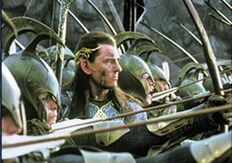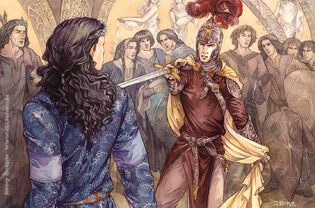Tộc Ñoldor là tộc thứ hai của người Elves, tên của tộc có nghĩa là Những người Hiểu biết. Theo truyền thuyết, tên gốc của tộc này là Tatyar, mang nghĩa Những kẻ Thứ nhì, do ông tổ của tộc là Tata, người Elf thứ nhì tỉnh giấc ở vịnh Cuiviénen, cùng vị hôn thê Tatië và 54 người bạn đồng hành. Finwë là người Ñoldor đầu tiên tới Valinor, đi cùng với thần Oromë. Ông trở thành vua của tộc Ñoldor và dẫn đầu đoàn của họ tới Valinor. Những người Ñoldor tới được Aman đều nói tiếng Quenya với thổ âm Ñoldorin thông dụng. Tuy nhiên, nửa số người Tatyar gốc từ chối lời mời của các Valar, ở lại vùng đất trần thế và trở thành tộc Avari.

Đức Vua Gil Galad và đội quân Ñoldor trong phim Chúa tể Những chiếc Nhẫn
Tộc Ñoldor còn được gọi là Noldoli, hoặc Những người Elves Thâm trầm, hoặc Golodhrim, Aulendur ('Bầy tôi của thần Aulë') và Golug. Họ
thường có mái tóc đen (trừ những người có lai huyết thống Vanyar, trong đó đáng kể nhất là Dòng họ Finarfin). Người Ñoldor được coi như đứng đầu trong loài Elves về độ thông thái và trình độ nghề rèn. Fëanor (con trai của Finwë và Míriel) là người giỏi nhất về nghề rèn trong số họ, đồng thời là Đức Vua Tối cao thứ hai và có thời gian trị vì ngắn nhất. Khi Melkor giết chết Finwë và đánh cắp ba viên Silmarils, Fëanor gọi tên Melkor bằng Morgoth (“Kẻ thù Hắc ám”) và thuyết phục tộc Ñoldor truy đuổi hắn tới Middle-earth và phát động chiến tranh với hắn.
Lịch sử[]
Ở Valinor, người Ñoldor sống dưới sự trị vì của Đức vua Tối cao Finwë. Họ làm bạn và trở thành học trò của Thần Thợ rèn Aule, vì họ yêu thích nghề rèn và những kiến thức trong nghề mà Aule truyền đạt cho họ. Vợ của Finwë là Miriel sinh hạ người con trai duy nhất, Fëanor, trước khi bà lìa đời. Finwë rất đau buồn trước mất mát này, bù vào đó, người con Fëanor đã lớn lên mạnh khỏe và trở thành một vị Chúa tể Elf hùng mạnh: khôn ngoan trong lời nói, và khéo léo bậc nhất trong các nghề thủ công. Khi đạt đến đỉnh cao, Fëanor đã rèn nên ba viên Silmarils, món châu báu chứa đựng ánh sáng của Hai Cây Thần. Nhưng ông là một kẻ kiêu ngạo và tự phụ; ông không bằng lòng khi phụ thân tái hôn với Indis của tộc Vanyar. Ông không yêu quý hai người em cùng cha khác mẹ là Fingolfin và Finarfin, đó là mầm mống bất hòa trong Gia tộc Finwë.

Fëanor đe dọa Fingolfin
Khi Melkor được các Valar thả tự do, hắn tìm cách lợi dụng mối bất hòa đó để đánh cắp ba viên Silmarils và ly gián người Ñoldor khỏi các Valar. Hắn tung ra những lời dối trá với người Ñoldor, bảo họ rằng các Valar giữ họ lại Aman để họ không thể cai quản vùng đất Middle-earth, rằng hai anh em Fingolfin và Fëanor đang ngấm ngầm đối đầu với nhau. Khi Fëanor tuốt kiếm đe dọa Fingolfin, các Valar phải can thiệp và trục xuất Fëanor khỏi Valmar, đày ông tới khu thành trì Formenos trên núi. Tộc Ñoldor trở nên ăn không ngon ngủ không yên khi họ bắt đầu thèm muốn những vùng đất không người cai quản của Middle-earth.
But worse was to come. When Melkor destroyed the Two Trees of Valinor and slew Finwe, he also stole the Silmarils and fled to Middle-earth. An enraged Fëanor then spoke before all of the Ñoldor and gave an impassioned speech. He urged them to leave the land of the Valar and take up kingdoms in Middle-earth, where they could rule as they wished. Many of the royal line, including Galadriel, wished indeed to see Middle-earth and rule their own fair kingdoms. Fëanor then swore a terrible Oath to reclaim the Silmarils, with the promise of retribution for any who should withhold them. The Ñoldorin Host gathered, though the greater part followed Fingolfin, trusting his wisdom over Fëanor's arrogance.[3]
Before the First Age the Ñoldor led by Fëanor went north and demanded that the Falmari let them use their ships. When the Falmari refused, Fëanor and his host destroyed the port of Alqualondë, which had been built by the Teleri, committing the first Kinslaying. Fëanor's host then took possession of the ships. Not long afterwards, the Ñoldor were confronted by Mandos, the Doomsman of the Valar. Mandos delivered the Prophecy of the North, pronouncing doom on the Ñoldor for the Kinslaying and warning that if they continued they would not recover the Silmarils and moreover that there would be great grief in the tragedy that would befall them. At this, some of the Ñoldor who had no hand in the Kinslaying, including Finarfin son of Finwë by Indis, returned to Valinor, and the Valar forgave them. Other Ñoldor led by Fingolfin son of Finwë by Indis (some of whom were blameless in the Kinslaying) remained determined to leave Valinor for Middle-earth. Prominent among these others was Finarfin's daughter, Galadriel.
Fëanor and his host crossed the sea to Middle-earth leaving those led by Fingolfin, his half-brother, behind. Upon his arrival in Middle-earth, Fëanor had the ships burned. When Fingolfin and his host discovered their betrayal, they went farther north and crossed the sea by means of the Helcaraxë. Many of them died while crossing the paths of the Helcaraxë and the cruel hills of ice, including Turgon's wife Elenwë. The departure of the Ñoldor out of the Undying Lands marked the beginning of the First Age, and the years of the Sun. At last, the Host of Fingolfin arrived in Middle-earth, and their journey through the Helcaraxë was one of the greatest deeds of renown. Few deeds of the Ñoldor would ever surpass this, but the bitterness of the crossing had kindled fresh hatred for the House of Fëanor.[4]
Fëanor's company was soon attacked by Morgoth. When Fëanor rode too far from his retinue during the Battle under Stars (year 1 of the First Age) he was slain by Gothmog and the other Balrogs.
Because Fëanor had taken the ships and left the remaining Ñoldor in Aman, the royal houses of the Ñoldor were feuding. But recently Maedhros, eldest son of Feanor, had been captured by Morgoth. Fingon, son of Fingolfin, who remembered great friendship between himself and Maedhros, rescued him from the slopes of Thangorodrim. For this deed the Noldor rejoiced and their feud was ended. By right Maedhros had succeeded Fëanor as King, but in gratitude he renounced the Kingship to his uncle Fingolfin, who became the third High King of the Ñoldor. His brothers did not agree to this, and began to refer to themselves as the Displaced, because the High Kingship had passed them by. Nevertheless, the princes of the Ñoldor established great realms in Beleriand, and to many it seemed the words of Feanor were justified. Here the Ñoldor were mighty and lordly, rather than at the bottom of the hierarchy in Valinor. And for a while there was peace between the Houses of Fingolfin and Fëanor. But the House of Fëanor was still bound by the Oath, which in turn was tied to the Curse of Mandos.[5]
Fingolfin reigned long in the land of Hithlum, and his younger son Turgon built the hidden kingdom Gondolin. Fingolfin's reign was marked by warfare against Morgoth and in the year 75 of the First Age the Ñoldor started the siege of Angband, the great fortress of Morgoth. But in the year FA 455 the siege was broken by Morgoth (in the Dagor Bragollach), and Fingolfin perceived that the war against Morgoth was utterly futile. In his fury, Fingolfin rode to Angband and challenged Morgoth to single combat. Reluctantly, Morgoth came forth to duel him. Fingolfin dealt Morgoth seven wounds from which he never healed, but at last Fingolfin was slain. Thorondor, Lord of Eagles, scratched Morgoth's face and took Fingolfin's body. His eldest son Fingon succeeded him as High King of the Ñoldor.
In the year 471, Maedhros organized an all-out attack on Morgoth and this led to the Nirnaeth Arnoediad. The battle was a great disaster for the Ñoldor, and Fingon the Valiant was slain. He was succeeded by his brother Turgon, but Fingon's son Gil-galad was sent to the Havens.
Thông tin bài viết:[]
- Nguồn : Lord of the Rings Wiki
- Biên dịch : Proud Foot
- Ngày dịch : 11-12-2017
- Lưu ý : Nếu bạn đăng lại bài viết, đề nghị hãy ghi tên người dịch hoặc dẫn link.